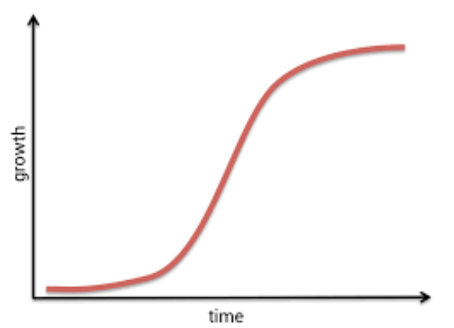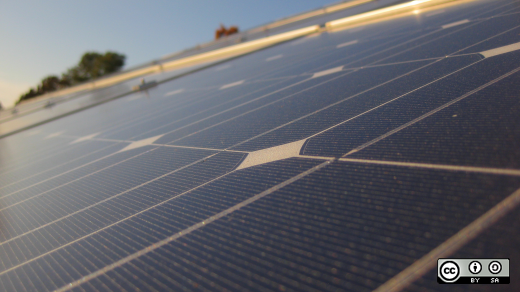Many people talk a lot about the values of Open Organization Principles, but in many ways, they require people to change how they do things, which can be difficult. That is true for businesses and industries as well. Disruption in many sectors is coming. How do we use Open Principles to address them? This article looks at what's happening in industries related to energy and transportation when it comes to drastic costing changes that will lead to industrial disruption.
Business disruption is happening through new technology or methods, which will slash costs. This is forcing industrial change. Consider the oil, coal, natural gas, nuclear, petroleum, biofuels, and charcoal (the primary energy in many developing countries) industries. All these industries are grouped in the fossil fuel-burning energy-generating industry. Imagine them all becoming obsolete and totally replaced by the solar and wind industries in the next decade or so because of costs. That is industrial disruption.
As a resource, I have read, Clean Disruption of Energy and Transportation, by Tony Seba.
The book was written before 2014, but many of his concepts are valid today. In his book, Seba presents an energy-usage case for electric vehicles (EV) replacing internal combustion engine vehicles (ICE), and the entire automotive industry shrinking with autonomous (self-driving) car disruption strictly on cost factors. If this is true, adapting to those changes will be required, and Open Organization Principles can be helpful.
He also builds a case for current electrical power generation being completely replaced in the years ahead by solar and wind with battery storage based strictly on cost competitive advantages. I discussed this in my article on Jeremy Rifkin's book The Zero Marginal Cost Society: The Internet of Things, the Collaborative Commons, and the Eclipse of Capitalism.
Seba's book reminds me too of Michael E Porter's five competitive forces the force of substitutes.
For example, automobiles replaced the horse and carriage in about a decade in the early 1900s, and digital cameras replaced all film cameras on the market. This replacement was due to:
- A cost advantage with prices coming down at exponential rates (from dollars to pennies like computer sizes to computing capacity) through increased innovation, scale, and competition.
- Superior product features.
- Added new product features,
- Central control replaced by distributed/shared control.
For these reasons, in the past, products became obsolete by something innovative. They were disrupted.
Imagine wanting to make an open organization community that can produce its own electricity instead of being forced to buy electricity at much higher prices. Could such a community be formed? Throughout his book, Seba makes a case that this is possible using the four above factors.
This article is the first of a two-part series on this topic. This article gives strategies for open organization communities on the use of electric vehicles over internal combustion engined (ICE) cars, the use of self-driving vehicles over human-driving vehicles, and the use of solar power generation over nuclear power generation. I'll give more in the second part of this series.
A question of power
Seba assumes that electrical power is a commodity with no distinct quality difference and that there is no such thing as high-quality and low-quality electricity to the user. The only difference is the price of electricity at a given time.
The price of electricity fluctuates greatly. He also assumes that the automotive industry only has one quality, the movement of goods and people. Therefore, Seba's whole book looks at the cost (particularly end-user price) of both electricity (in kilowatt/hours) and movement (miles/kilometers over the life of a vehicle). He does a wonderful job of breaking down indirect and direct costs in great detail, including many costs I had never considered. This seems to be the same conclusion Jeremy Rifkin came to, calling it marginal costs in his book, The Zero Marginal Cost Society (cited above).
By providing general cost breakdowns, Seba enables readers to seriously consider how they and their community might use solar and wind electric power generation. One could build an open organization community based on the information this book makes available.
Coincidentally, I've just read Bill Gates' book, How to Avoid a Climate Disaster. Gates' book has one primary goal: To remove 51 billion tons of greenhouse gases from the atmosphere by 2050. Gates would love it if Seba's prediction comes true.
Seba believes that by 2030, all electricity generation and vehicles on the road will be carbon-free. Seba believes that over a 10-15 year period disruptive forces will penetrate industries in an "S" shaped growth. They will start slowly while the users adjust to this new purchasing option.
Then, once several success stories are in operation, disruption will take off like a rocket, making all old technology and processes obsolete. After several decades, the demand will flatten when the disruptive technology fully serves the market.

(Ronald McFarland, CC BY-SA 4.0)
Here is how the "S" demand works for electrical energy according to Seba:
- Some solar and wind systems are accepted in the market, making capital more available and less costly.
- More creative financing plans are developed and offered.
- Local, distributed energy generation increases.
- The business structure of energy flips from centralized to distributed.
- Enabling technologies, such as sensors, artificial intelligence, big data, and mobile communications, improve exponentially. Sensors, smaller and more energy efficient than ever before, will have more information on energy usage than any conventional utility could ever obtain.
- The increasing cost of resource-based energy will push more people away from them.
- Complementary markets, such as wind power generation, electric vehicles, and self-driving cars will increase exponentially.
- Investments in other storage technologies for shared solar facilities, wind operations, electric vehicles, and self-driving cars will increase.
- The business environment of energy will become more and more distributed.
- The conventional command-and-control energy business model will enter a vicious cycle of rising prices and obsolete assets.
Seba writes, "World demand for energy is expected to be 16.9 TW by 2030, according to the US Energy Information Agency." That may seem dire, but Seba adds, "Should solar continue on its exponential trajectory, the energy generation will be 100% solar by 2030."
I'm sure that Gates would be delighted if that turns out to be true, but he is taking no chances on just those predictions. Gates is investing in future nuclear power plants and carbon capture systems for current fossil fuel burning plants to reduce carbon dioxide emissions further.
Building a community
Assume we want to build an open organization community to introduce three things:
- The use of electric vehicles (EV) over internal combustion engined (ICE) vehicles.
- Self-driving vehicles over human-driven vehicles.
- Solar power generation over nuclear power generation.
Here is additional detail on Seba's arguments for each.
1. Use of electric over internal combustion engined vehicles
Consider the following attributes of EV over ICE vehicles:
- Seba presents that an electric vehicle is inexpensive to operate. An EV is five times more efficient in energy use than ICE vehicles. That makes an EV 10 times cheaper than ICE.
- An electric vehicle is cheaper to maintain because it contains few moving parts.
- In the future, there will be wireless charging stations along the road, so vehicles need not stop to charge. ICE vehicles will always have to stop at filling stations.
- Electric vehicles are safer, with more safety sensors.
- By 2025, EVs will likely be cheaper to purchase than ICE, with battery costs coming down rapidly.
- Battery performance and range are increasing with new developments.
- Electric vehicles can gather driving data in real-time for added safety, performance analytics, and future improvements.
- Electric vehicles can use excess electricity in the owners' home solar system or sell the excess to the local utility company.
- An EV company can offer free fuel and maintenance for five years if it wants to. No ICE vehicle manufacturer can do this.
2. Use of self-driving vehicles over human-driving vehicles
Young people are moving away from owning vehicles in favor of Uber or Lyft services. It is becoming cheaper in the long term. Ride-sharing offers many advantages, including:
- Each Uber/Lyft vehicle on the road is estimated to replace around 15 cars purchased. This result shrinks the overall vehicle numbers, impacting the need for parking lots and vehicle insurance.
- Owning an asset used less than 10% of the time is not practical. Most cars are parked most of the time, except for commercial vehicles that operate during work hours.
The next step is self-driving cars, according to Seba. When self-driving cars are fully in the market, there will be disruption in the automotive, transportation, logistics, and oil industries. Self-driving cars will be mainly purchased, owned, and operated by corporations with fleets, not individuals.
Self-driving cars provide many advantages, a few of which are listed here:
- Self-driving cars expand the transportation of people. Children, the elderly, and those with disabilities will be new customers.
- The benefits of self-driving cars include:
- Save lives (no human error, advanced machine learning, and sensing).
- Save time (less time on the road with less congestion or looking for parking spaces).
- Save space (fewer roads, garages, and parking spaces required).
- Save energy (lower fuel consumption).
- Save money (in purchasing, operating, maintaining, and insuring for transportation).
- The cost of transportation will be cheaper, safer, and easier.
3. Use of solar power generation over nuclear power generation
Solar power generation pricing is falling rapidly and is projected to continue falling with more use. This is where the Internet of Things (IoT) comes in. While nuclear power costs will also come down, it's not competitive, particularly as decommissioning is extremely expensive.
Here are some considerations for solar power generation:
- Solar cost has improved by 1,540 times since 1970. Based on Seba's research, solar costs are expected to come down by another two-thirds by 2020 (at the time the book was written in 2014).
- Currently, operating nuclear power plants' costs are increasing and are continually over budget in cost. If their costs don't come down, they will phase out. Bill Gates is betting on improved low-cost designs.
- Solar panel costs have dropped by a factor of US$100/Wh (Watt-hour) to 65¢/Wh from 1970 to around 2012, far lower than nuclear prices.
- New nuclear power plants are expected to provide electricity at 25¢/kWh-30¢/kWh. That is not competitive, with solar being around 12.5¢/kWh. In the United States, residential customers pay around 12.5¢/kWh, and some solar power suppliers expect to reach 5.79¢/kWh soon.
- Nuclear power generation uses twice as much water as natural gas, which is 10,000 times more than solar. This places added stress on the freshwater supply.
- There are now solar manufacturing companies providing power 24 hours/day. Torresol Gemasolar is a company in Spain putting one of these facilities into operation. They use safer and cheaper molten salt thermal energy storage. This energy storage method is a tenth of the cost of Li-on batteries.
- Seba says, "Large, centralized, top-down, supplier-centric energy is on the way out. It is being replaced by modular, distributed, bottom-up, open, knowledge-based, consumer-centric energy." For solar, many users will also be producers and sharers of electricity and information.
- Solar now regularly provides 20-35% of Germany's power. That will continue with improved battery storage, especially as Germany moves away from Russian oil and gas due to the war in Ukraine. Both for residential and commercial solar plants, tens of thousands of power generation units are being installed in the United States, Europe, and Australia.
- In 2014, 430 reactors in 31 countries provided 370 GW of nuclear power capacity, mainly in France, Japan, Russia, and the United States. These most likely will be replaced with solar, wind, or 4th generation nuclear, which uses waste as fuel. Europe will shut down 80% of its 186 nuclear power plants by 2030 (Global Data). Many current nuclear power plants are close to their shutdown age.
- Nuclear power plants are not insurable at any premium, so only governments protect them.
Wrap up
In the second part of this series, I'll discuss ideas regarding the use of solar power generation over oil power generation, the use of solar power generation over natural gas (with methane) power generation, the use of solar power generation over biofuels power generation, the use of solar power generation over coal power generation, and distributed electricity generation (small and simple) over conventional large utilities.






Comments are closed.